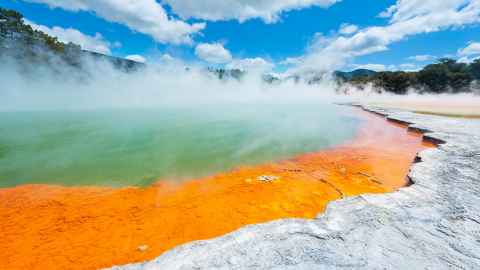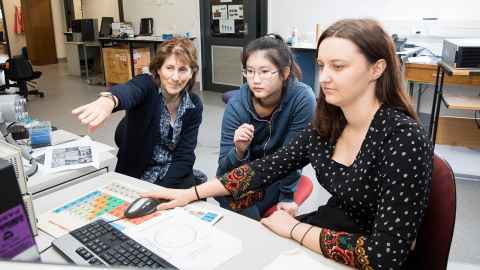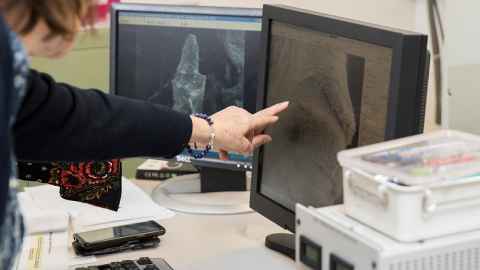Some liked it hot
9 December 2019
The relentless quest to prove whether there once was life on Mars is a key driver behind two trans-Tasman research initiatives that are simultaneously looking into the evolution of microbes in hot pools near Rotorua and beneath the parched red earth of Western Australia.

IRONICALLY, THE ROTORUA research is being funded by the Australia Research Council while a West Australian drilling campaign is supported by a New Zealand Marsden grant, but Professor Kathy Campbell from the School of Environment says they share a common purpose.
“Each one of the projects ties the bigger picture together about early life in our Solar System. Did it only happen on Earth? Or did it also happen on Mars?”
Exploring the geothermal mixing zones of Rotorua
The Rotorua project aims to get a better understanding of the biological influences on the formation of silica-rich hot spring deposits that may be morphologically similar to the cauliflower-shaped knobby growths of silica known as spicules that were discovered by NASA’s Mars exploration rover, Spirit.
All the nutrients for life can be found in hot pools that have very different chemistries, temperatures and colours. The research focus is on the so-called ‘mixing zones’ where outflows meet. “Maybe it’s in those zones where things get complex in the pre-biotic chemistry,” says Kathy. “Is that the place where you generate the spark for life?”
School of Environment PhD student Chanenath ‘Kitty’ Sriaporn from Thailand is studying the microbiology and says she loved star gazing as a youngster. “I find this stuff quite fascinating, the origins of life and the possibility of there being extraterrestrial life.”
In addition to sampling the Mars-like spicules in Rotorua, Kitty is looking at the microecology of the pools to determine what organisms live where and what they’re doing. “Could this environment lead to more evolutionary streams of some life forms?Do they favour adaptation and mutation, and if so, was it also possible for this to happen three billion years ago?”
While it is too early to draw any conclusions, Kitty says that organisms living in the New Zealand hot springs tend to be further along the evolutionary chain – and more robust – than similar organisms found elsewhere. “The strains that we found at the hot springs here tend to have a higher evolutionary distance – they have evolved more,” she says.
Along the way, Kathy is challenging the age-old theory that life on Earth evolved from hydrothermal vents in the ocean. “What if life evolved on land instead of the sea and went in the opposite direction?”
While she admits that life on land early in the Earth’s history would have been “horrible” because of the extra UV radiation, Kathy says that microbes in hot springs may have been protected from the radiation by minerals like silica – whereas the ocean environment was simply too diluted for the right chemistry to occur. “It’s this question of where did life originate? Could it have originated in mixing zones in hot pools – on land?”
It’s this question of where did life originate? Could it have originated in mixing zones in hot pools – on land?

Pilbara’s ancient hot spring deposits yield clues
More than five thousand kilometres away in the Pilbara region of Western Australia, another School of Environment PhD student, Michaela Dobson, has been looking for signs of early life in 3.5 billion-year-old hot spring deposits. As Kathy puts it, “getting down into the nitty-gritty of the relationship between the microbes and the minerals that preserve them.”
Michaela chose geology as a core subject and spent time around Rotorua’s Hells Gate geothermal area, where she completed her fourth-year honours, before being recruited to analyse the fresh core samples that have been drilled from 70 metres below the rusty surface of Pilbara.
“You need to study fresh drill cores underneath the red weathered land surface to understand the original environmental conditions under which the organisms were living,” Kathy says. “That tells you what type of chemistry these organisms were using. They were doing some sort of sulphur cycling and then sulphate and sulphide minerals were forming around the microbes.”
Using a hand lens and various scanners, the cores are being logged to identify any microbial or mineral remnants that compare to those found in Rotorua. “Is it like a hot spring in Rotorua or is it more like a deep-sea vent – or something else?” says Kathy.
So far the UNSW-UOA* group’s research has produced a couple of surprises, one being possible evidence of the bio-mediated geyserite that forms around hot spring geyser vents which Michaela says “may be the earliest evidence of life on land.”
What was totally unexpected was the discovery of tiny spherical shards of glass that appear to be impact spherules that resulted from asteroid strikes 3.5 billion years ago. “That’s exciting,” Kathy says, “because it’s new and could be one of the earliest examples of impact horizons that might have frustrated the life that was starting to grow. Or it might have somehow enhanced it by bringing nutrients and rich elements from outer space – we don’t know.”
* University of New South Wales – University of Auckland.

Maybe it will be human exploration of Mars in the future that locates the microbial Martians that may be lurking there.
Discovering past life on Mars
What Kathy really wants is to retrieve samples from Mars; however, her hope that a new rover mission scheduled for launch in July 2020 might do just that were dashed when NASA chose a different location to the site where the Martian geothermal features were detected.
Not to be denied, she and colleagues are now pitching a Mars mission proposal to the Japan Aerospace Exploration Agency (JAXA). Kathy describes JAXA as “a whiz at landing on asteroids and bringing back samples”, not to mention Japan’s very high-tech laboratories for analysis.
One impediment to the Japanese mission might be the high price tag but, like Mr Spock of Star Trek fame, Kathy would love to go back and “interrogate the samples” while NASA’s Captain Kirk approach explores new and amazing things over the horizon. “We think Mr Spock is going to find life on Mars and we’re not totally sure that Captain Kirk will,” she muses.
A key feature of the research effort is the international collaboration with other groups conducting similar work in Chile’s El Tatio geyser field high in the Andes and North America’s Yellowstone National Park.
“It’s a very wide web that we’re connected to,” Kathy says. “There are lots of different people working on the question of whether there is any other life in our Solar System past or present and it’s the researchers who are driving the direction of the science rather than any specific country or institution.”
That said, the University of Auckland’s Te Ao Mārama – Centre for Fundamental Inquiry is playing its part by connecting researchers across disciplines. The new Te Pūnaha Ātea – Auckland Space Institute will add further impetus by perhaps contributing engineering expertise to the proposed Japanese space mission.
As for the future, Kitty is likely to eventually return to Thailand to work for the National Astronomical Research Institute (NARIT) which Kathy says will boost collaboration with that country. Once her PhD is completed, Michaela likes the idea of doing a post doc at one of the world’s big research centres before becoming a lecturer.
For Kathy, her lifetime of extreme environment research is ongoing, but she concedes that if JAXA doesn’t pick up the Mars mission and NASA is busy elsewhere then it might take quite a long time to find out whether life evolved on Mars. “Maybe it will be human exploration of Mars in the future that locates the microbial Martians that may be lurking there.”
inSCight
This article appears in the December 2019 edition of inSCight, the print magazine for Faculty of Science alumni. View more articles from inSCight.
Contact inSCight.